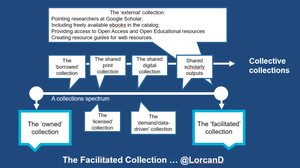The discussion about mass digitization and the growing number of off-site storage initiatives have heightened interest in what I have called the collective or aggregate collection.
Over the coming years we will take a more active role in managing aggregate or collective collections: thinking about the best disposition of collections within particular inter-institutional policy environments. The opportunity costs of managing print collections will ensure that this happens. : [Lorcan Dempsey’s weblog: The anatomy of an aggregate collection]
In this context, union catalogs come into their own. Ideally, one would like to make decisions based on good data, in terms of distribution of materials and their use. We do not have good aggregate circulation data, but in many cases we can actually say quite a bit about distribution.
I make these remarks in the context of some work carried out by Roger Schonfeld, of Ithaka, and my colleage Brian Lavoie. They make some observations about the aggregate book collection represented in Worldcat.
Questions addressed in this paper touch on some of the salient features of the system-wide print-book collection. How many titles does the system contain? What holdings patterns prevail within the system, especially in regard to the degree of overlap and the incidence of rare or unique materials? What are some of the characteristics of the print books in the system-wide collection, such as date of publication and language? This study offers only a brief sketch of the system-wide print book collection, with the objective of providing some examples of the kinds of data that could usefully be collected and applied. Ultimately, we hope this view of the system-wide print book collection helps libraries gain a fresh perspective on their collections, especially as they evaluate future needs and opportunities. [The Journal of Electronic Publishing]
This work complements the more specific analysis available in Brian Lavoie, Lorcan Dempsey, and Lynn Silipigni Connaway, “Anatomy of Aggregate Collections: The Example of Google Print for Libraries,” D-Lib Magazine 11, no. 9 (2005).
Related entries:



